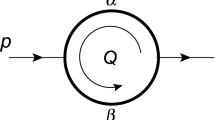Abstract
The theory of Riordan arrays studies the properties of formal power series and their sequences. The notion of generalized Lagrange series proposed in the present paper is intended to fill the gap in the methodology of this theory. Generalized Lagrange series appear in it implicitly, as various equalities. No special notation is provided for these series, although particular cases of these series are generalized binomial and generalized exponential series. We give the definition of generalized Lagrange series and study their relationship with ordinary Riordan arrays and, separately, with Riordan exponential arrays.
Similar content being viewed by others
References
L. Shapiro, S. Getu, W. Woan, and L. Woodson, “The Riordan group,” Discrete Appl. Math. 34, 229–339 (1991).
R. Sprugnoli, “Riordan arrays and combinatorial sums,” Discrete Math. 132, 267–290 (1994).
N. Cameron and A. Nkwanta, “On some (pseudo) involutions in the Riordan group,” J. Ineger. Seq. 8, 1–16 (2005).
G. Cheon, H. Kim, and L. Shapiro, “Riordan group involutions,” Linear Algebra Appl. 428, 941–952 (2008).
W. Wang and T. Wang, “Generalized Riordan arrays,” Discrete Math. 308, 6466–6500 (2008).
S. M. Roman and G.-C. Rota, “The umbral calculus,” Adv. Math. 27, 95–188 (1978).
S. M. Roman, Umbral Calculus (Academic Press, New York, 1984).
A. V. Ustinov, “Korobov polynomials and umbral analysis,” Chebyshevskii Sb., No. 4, 1–12 (2003).
R. Graham, D. Knuth, and O. Patashnik, Concrete Mathematics: A Foundation for Computer Science (Addison-Wesley Publ., Reading, MA, 1989; Mir, Moscow, 1998).
R. Sprugnoli, “Riordan arrays and Abel-Gould identity,” Discrete Math. 142 (1-3), 213–233 (1995).
E. Brietzke, “An identity of Andrews and a new method for the Riordan array proof combinatorial identities,” Discrete Math. 308, 4246–4262 (2008).
V. E. Hoggatt, Jr. and P. S. Bruckman, “H-convolution transform,” Fibonacci Quart. 13 (4), 357–368 (1975).
Author information
Authors and Affiliations
Corresponding author
Additional information
Original Russian Text © E. V. Burlachenko, 2016, published in Matematicheskie Zametki, 2016, Vol. 100, No. 4, pp. 510–518.
Rights and permissions
About this article
Cite this article
Burlachenko, E.V. Riordan arrays and generalized Lagrange series. Math Notes 100, 531–539 (2016). https://doi.org/10.1134/S0001434616090248
Received:
Accepted:
Published:
Issue Date:
DOI: https://doi.org/10.1134/S0001434616090248




